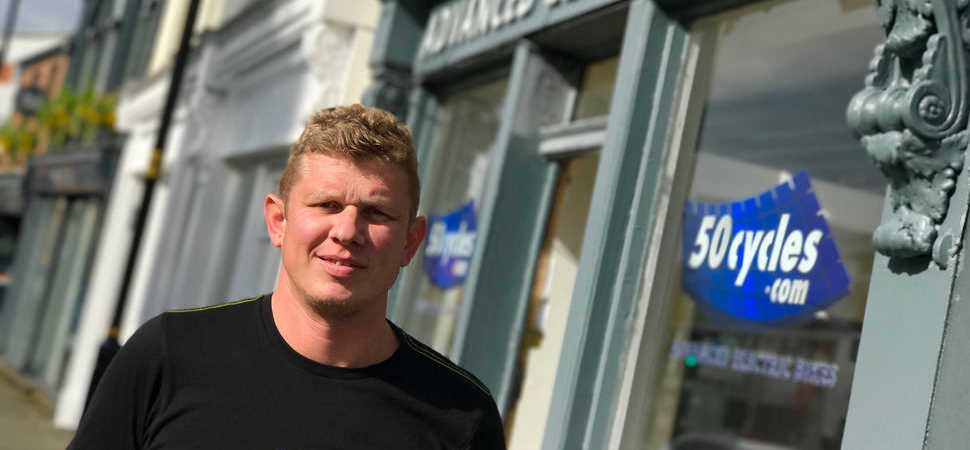
"At present e-bike riders are being hamstrung by ill-informed European laws"
Scott Snaith, founder of E-Bike retailer Cycles
BRISTOL’S streets will be safer for cyclists when the Government relaxes the laws on electrically-powered e-bikes.
That’s according to one leading cycling expert, who was speaking at this week’s Public Health & Sustainable Transport Summit 2019, held at City Hall.
As it stands, an e-bike’s electric motor must, by law, cut out when the bikes is travelling more than 15.5mph. It must also have a maximum power output of 250 watts.
But Scott Snaith, founder of UK firm 50Cycles, says 15.5mph is too slow - and dangerous - when it comes to keeping-up with modern traffic.
And he’s also calling for the motor’s power output to be DOUBLED to 500 watts to protect e-bike users.
He explains: “E-bikes are becoming more and more popular in the UK.
“And the appeal is obvious. Because an electric motor acts as a boost to human pedal power, they’re easy to ride up hills or to maintain speed in traffic.
“But setting a 15.5mph speed limit is not realistic and, in my view, actually creates a danger for e-bike riders. It’s simply too slow compared to the traffic all around e-bike riders.
“And by upping the speed to 20mph before the motor shuts off, you’re talking about a rider getting away from a roundabout quicker, or being able to accelerate out of harm’s way.
“At present e-bike riders are being hamstrung by ill-informed European laws.”
An Electrically assisted Pedal Cycles - an ‘EAPC’ or ‘ebike’ for short - is a standard bike fitted with an electric motor.
You don’t need to licence to ride one and it doesn’t need to be registered, taxed or insured.
But, according to current UK laws, if the motor kicks in above 15.5mph the bike is deemed a ‘moped’ and a rider would need to be registered with the DVLA, have proper insurance, and would legally-bound to wear a helmet.
Upping the limit to 20mph would also have a massive impact on couriers - with more and more delivery drivers opting for e-bikes.
Scott, who recently launched a next-generation ‘TOBA’ e-bike, which earns riders cryptocurrency as they cycle, adds: “We recently handed a courier a free e-bike to see what the benefits were compared with a traditional cycle.
“And he ended up completing 30 ‘drops’ per day as opposed to 16, because he can ride further and faster.
“He boosted his weekly income, but the knock-on effect for other cyclists is that he represents a driver not using a car or motorcycle.
“It’s a massive win for every sector of the economy.
“If we can increase the speed of e-biking to 20mph - in line with many pedestrian speed limits for cars - we widen the net of the appeal of cycling, with all the intrinsic benefits.
“It reduces congestion and pollution for all users of the transport system allowing a more efficient system.”
Ebikes accounted for just 5 per cent of the UK bike market in 2015, but that accelerated to 12 per cent in 2016.
According to the latest stats from HMRC, imports of e-bikes have jumped from 50,000 to 62,500 in the last year alone.
More recently, Halfords described a 220 per cent increase in e-bike sales.
Scott adds: “Getting back on two wheels in adulthood can be a fairly daunting experience, but it needn’t be with an ebike. They act as a gateway to riding and for exercising in general.
“We should do all we can to make it an enjoyable and safe form of transport.”
The Public Health & Sustainable Transport Summit, held March 27, saw keynote speakers covering a range of debates they hope will act as ‘practical blueprints for change’.
Topics included air quality initiatives, cycling as a means to boost the nation’s health, as well as cross sector collaborations and funding.
It was organised by the Department for Transport In partnership with Public Health England.
http://landor.co.uk/transporthealth/2019/home.php
www.50cycles.com
FACTFILE: E-BIKES EXPLAINED.
- An Electrically assisted Pedal Cycles - an ‘EAPC’ or ‘ebike’ for short - is governed by European law.
- An E-bike is legally allowed to feature an electric motor which provides a boost to human pedal power - but which must cut-off when the bike is travelling more than 15.5mph.
- If the motor kicks in above 15.5mph, the bike is classed as a ‘moped’ and you’ll need to be registered with the DVLA, have proper insurance, and legally-bound to wear a helmet.
- As with standard pedal bicycles, there is currently no mandatory legal requirement to wear a helmet when using an EAPC.
- You don’t need a licence to ride one and it doesn’t need to be registered, taxed or insured.
- You must, however, be 14 or over to ride one in England, Scotland and Wales.
- A new sub-category of E-bike was approved by the EU in October 2018.
- The new 'L1e-A classification’ - allows e-bikes to be powered by motors of up to 1000 watts. Power output can be regulated entirely by a throttle, too, without the need to pedal.
- The 15.5mph cut-off limit stills stands.
- The L1e-A bikes have to be licensed and insured - but there’s no legal requirement to wear a helmet and they can still be used on a cycle path.


